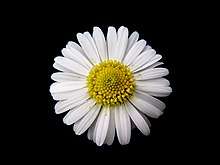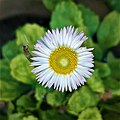Bellis perennis
Bellis perennis is a common European species of daisy, of the family Asteraceae, often considered the archetypal species of that name.
| Bellis perennis | |
|---|---|
 | |
| Scientific classification | |
| Kingdom: | Plantae |
| Clade: | Tracheophytes |
| Clade: | Angiosperms |
| Clade: | Eudicots |
| Clade: | Asterids |
| Order: | Asterales |
| Family: | Asteraceae |
| Genus: | Bellis |
| Species: | B. perennis |
| Binomial name | |
| Bellis perennis | |
| Synonyms[1] | |
| |
.jpg)
Many related plants also share the name "daisy", so to distinguish this species from other daisies it is sometimes qualified as common daisy, lawn daisy or English daisy. Historically, it has also been commonly known as bruisewort and occasionally woundwort (although the common name woundwort is now more closely associated with Stachys). Bellis perennis is native to western, central and northern Europe, including remote islands such as the Faroe Islands but widely naturalised in most temperate regions including the Americas[2][3] and Australasia.
Description
It is a perennial herbaceous plant with short creeping rhizomes and rosettes of small rounded or spoon-shaped leaves that are from 3/4 to 2 inches (approx. 2–5 cm) long and grow flat to the ground. The species habitually colonises lawns, and is difficult to eradicate by mowing – hence the term 'lawn daisy'. Wherever it appears it is sometimes considered an invasive weed.[4] It exhibits the phenomenon of heliotropism where the flowers follow the position of the sun in the sky.
The flowerheads are composite, in the form of a pseudanthium, consisting of many sessile flowers about 3/4 to 1-1/4 in (approx. 2–3 cm) in diameter, with white ray florets (often tipped red) and yellow disc florets. Each inflorescence is borne on single leafless stems 3/4 – 4 in (approx. 2–10 cm), rarely 6 in (approx. 15 cm) tall. The capitulum, or disc of florets, is surrounded by two rows of green bracts known as "phyllaries".[5] The achenes are without pappus.[6]
Cultivation
Bellis perennis generally blooms from early to midsummer, although when grown under ideal conditions, it has a very long flowering season and will even produce a few flowers in the middle of mild winters.[7][8]
It can generally be grown in USDA Zones 4 – 8 (i.e. where minimum temperatures are above −30 °F (−34 °C)) in full sun to partial shade conditions, and requires low or no maintenance. It has no known serious insect or disease problems and can generally be grown in most well-drained soils. The plant may be propagated either by seed after the last frost, or by division after flowering.[7][9]
Though invasive, the species is still considered a valuable ground cover in certain garden settings (e.g., as part of English or cottage inspired gardens, as well as spring meadows where low growth and some color is desired in parallel with minimal care and maintenance while helping to crowd out noxious weeds once established and naturalised).
Numerous single- and double-flowered varieties are in cultivation, producing flat or spherical blooms in a range of sizes (1 cm to 6 cm) and colours (red, pink & white). They are generally grown from seed as biennial bedding plants. They can also be purchased as plugs in Spring.
It has been reported to be mostly self-fertilizing, but some plants may be self-sterile.[10]
Etymology

Bellis may come from bellus, Latin for "pretty", and perennis is Latin for "everlasting".
The name "daisy" is considered a corruption of "day's eye",[11] because the whole head closes at night and opens in the morning. Chaucer called it "eye of the day". In Medieval times, Bellis perennis or the English Daisy was commonly known as "Mary's Rose".[12] It is also known as bone flower.[13]
The English Daisy is also considered to be a flower of children and innocence.[14]
Daisy is used as a girl's name and as a nickname for girls named Margaret, after the French name for the oxeye daisy, marguerite.
Uses
Culinary
This daisy may be used as a potherb. Young leaves can be eaten raw in salads[15] or cooked, noting that the leaves become increasingly astringent with age.[7] Flower buds and petals can be eaten raw in sandwiches, soups and salads.[8] It is also used as a tea and as a vitamin supplement.[2]
Herbal medicine
Bellis perennis has astringent properties and has been used in herbal medicine.[16] In ancient Rome, the surgeons who accompanied Roman legions into battle would order their slaves to pick sacks full of daisies in order to extract their juice; bellum, Latin for "war", may be the origin of this plant's scientific name. Bandages were soaked in this juice and would then be used to bind sword and spear cuts.
Bellis perennis is still used in homeopathy for wounds and after certain surgical procedures,[17] as well as for blunt trauma in animals.[18][19] Typically, the plant is harvested while in flower when intended for use in homeopathy.[8]
Bellis perennis flowers have been used in the traditional Austrian medicine internally as tea (or the leaves as a salad) for treatment of disorders of the gastrointestinal and respiratory tract.[20]
Other uses
Daisies have traditionally been used for making daisy chains in children's games.[21]
- Bellis perennis in paintings
_-_Daisies_(1894).jpg) Daisies by William-Adolphe Bouguereau (1894)
Daisies by William-Adolphe Bouguereau (1894) The daisy chain by Maude Goodman (1936)
The daisy chain by Maude Goodman (1936)
Gallery
.jpg) Housefly on Bellis perennis
Housefly on Bellis perennis Closeup view of Bellis perennis
Closeup view of Bellis perennis
.jpg)

References
- The source The Plant List used was the International Compositae Alliance. "Bellis perennis L." The Plant List; Version 1. (published on the internet). Royal Botanic Gardens, Kew and Missouri Botanical Garden. 2010. Retrieved November 12, 2012.
- "Bellis perennis Linnaeus". Flora of North America.
- PLANTS Profile., "Bellis perennis L. lawndaisy", USDA Natural Resources Conservation Service. http://plants.usda.gov/java/profile?symbol=bepe2
- "Weeds of Northeast – USDA PLANTS". usda.gov.
- Stace, C. A. (2010). New Flora of the British Isles (Third ed.). Cambridge, U.K.: Cambridge University Press. p. 749. ISBN 9780521707725.
- Parnell, J. and Curtis. 2012. Webb's An Irish Flora. Cork University Press ISBN 978-1-85918-478-3
- "Bellis perennis L." Missouri Botanical Garden Bellis perennis.
- "Bellis perennis L". Plants for a Future database.
- "USDA Zones". USDA Plant Hardiness Zone Map. Archived from the original on 2014-02-27. Retrieved 2012-05-02.
- WARWICK, S. I.; BRIGGS, D. (September 1979). "The Genecology of Lawn Weeds". New Phytologist. 83 (2): 509–536. doi:10.1111/j.1469-8137.1979.tb07616.x. ISSN 0028-646X.
- "daisy facts, information, pictures – Encyclopedia.com articles about daisy". www.encyclopedia.com.
- The Plant-Lore and Garden-Craft of Shakespeare, by Henry Nicholson Ellacombe. W. Satchell and Company, London, 1884
- Nowick, Elaine (2014). Historical Common Names of Great Plains Plants, with Scientific Names Index: Volume II: Scientific Names Index. Lulu.com. p. 66. ISBN 978-1-60962-060-8.
- "Daisy." The Columbia Encyclopedia, 6th ed., 2011. Encyclopedia.com
- Johanna Budwig, Krebs – ein Fettproblem, richtige Wahl und Verwendung der Fette. Hyperion-Verlag, Freiburg im Breisgau 1956, p. 44: recipe for cancer patients.
- Howard, Michael. Traditional Folk Remedies (Century, 1987), p129
- "Pre-Surgical and Post-Surgical Treatment: from an ongoing series by". healthy.net.
- "Archived copy". Archived from the original on 2012-10-28. Retrieved 2012-05-02.CS1 maint: archived copy as title (link)
- "Bellis perennis – Veterinary Materia Medica of Homeopathic Remedies". petremedycharts.com. Archived from the original on 2016-12-22. Retrieved 2012-05-02.
- Vogl S, Picker P, Mihaly-Bison J, Fakhrudin N, Atanasov AG, Heiss EH, Wawrosch C, Reznicek G, Dirsch VM, Saukel J, Kopp B (October 2013). "Ethnopharmacological in vitro studies on Austria's folk medicine--an unexplored lore in vitro anti-inflammatory activities of 71 Austrian traditional herbal drugs". Journal of Ethnopharmacology. 149 (3): 750–71. doi:10.1016/j.jep.2013.06.007. PMC 3791396. PMID 23770053.
- "Children's 'right to play'". BBC News. BBC. 2002-08-07. Retrieved 2008-11-02.
External links
| Wikimedia Commons has media related to Bellis perennis. |
| Wikiquote has quotations related to: Daisies |
| Wikispecies has information related to Bellis perennis |